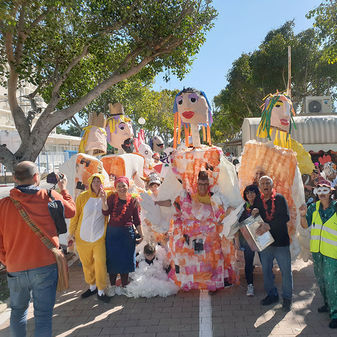About the Studio
The studio creates unique, large-scale projects in collaboration with the community, such as festival backdrops, dolls for ‘Adloyada’ (Purim) parades, and large or small projects adapted to each community.
As a team, we bring a large skill set which includes using different techniques, from working with soft materials to working with wood and iron.
The studio specializes in providing uniquely tailored ideas for diverse art activities with the community. No material nor technique limitation will prevent the realization of the community’s design.
The Studio Team
Creating in collaboration with the community encourages and strengthens ties and activities within the community that benefit the public. At the end of a joint work process, the community can take pride in quality art that reflects the joint effort and, in many instances, also the environmental and ecological importance.
The work process is a creative process that includes different techniques using various materials, and a studio team that is qualified to plan and adapt activities for the target audience while adhering to a timeline and fulfilling goals.
Since 2007, the studio has been working with heterogeneous groups of students from special education programs, teenagers, and seniors to create mobile pieces and stationary designs.
Carnival/Festival art requires preplanning and continuous work in heterogeneous groups varied in age while collaborating and creating using a variety of materials.
The necessary time for this project, forming and executing a large and colorful piece for the carnival or festival activity, is about six months.

Carnival and Festival Art
Art that is adapted to suit the community takes place in a communal area in collaboration with the community, using artistic tools.
This is a guided activity that begins with listening to the community’s needs and evolves into an empowering artistic activity that creates a safe and creative space.
After the goals have been determined, the studio team will lead the community to action, without judgment or criticism. They encourage mutual help, trust, and empathy towards each other, and give a personal touch based on the participants’ wishes and abilities.
At the end of the creative process, which provides a space for everyone, the community can take pride in a high-quality artistic and ecological project that improves the welfare of the community.































































